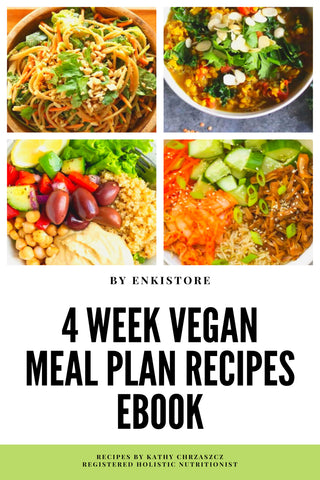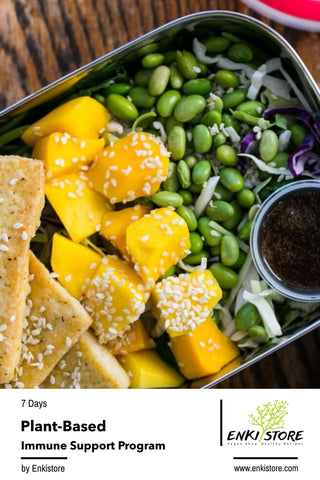The Ultimate Guide to Vegan Cooking: Tips and Tricks
May 09, 2023
Enki Store
The Ultimate Guide to Vegan Cooking: Tips and Tricks
Introduction
Veganism has been around for a long time, but recently it has become more and more popular. You might be wondering why. Well, it's because people are becoming aware of the negative impact that animal agriculture has on the environment and our health.
Not only is a vegan diet better for us, but it's also better for the planet. And that's not all - it's also kinder to animals.
But with this growing popularity comes a new set of challenges. More and more people are interested in trying veganism, but they don't know where to start.
That's where this ultimate guide to vegan cooking comes in! It's important to learn how to cook vegan meals so that you can enjoy all the benefits of a plant-based diet without sacrificing flavor or nutrition.
Brief Overview of Veganism and its Growing Popularity
Veganism is not just a diet - it's a lifestyle choice that seeks to exclude all forms of animal exploitation and cruelty. This includes not only what we eat, but also what we wear, use, and support through consumer choices.
The reasons people choose veganism are many: some do it for ethical reasons (to reduce animal suffering), others for environmental reasons (to reduce greenhouse gas emissions), some for health reasons (to reduce their risk of chronic diseases such as heart disease or cancer), while others do it simply because they enjoy the taste of plant-based foods. Whatever your reason may be - there is no denying that veganism is on the rise!
In fact, according to Google Trends data, searches for "vegan" have increased fivefold in the past five years alone! It seems like everyone is either trying out veganism or at least curious about it these days.
Importance of Learning How to Cook Vegan Meals
It's great that more and more people are becoming interested in veganism, but there is a problem - many of them don't know how to cook delicious, nutritious vegan meals. This can lead to frustration and ultimately failure in sticking with a vegan diet long-term. Not only is it important to learn how to cook vegan meals for practical reasons, but it's also essential for making sure you get all the nutrients your body needs.
Plant-based diets can be very healthy, but you need to make sure you're getting enough protein, vitamins, and minerals. By learning the basics of vegan cooking and experimenting with different ingredients, you'll be able to create delicious and balanced meals that will keep you feeling satisfied and energized.
The Basics of Vegan Cooking
What is a vegan diet?
Let's start with the basics. A vegan diet is one that excludes all animal products, including meat, dairy, eggs, and even honey.
Many people choose to follow a vegan diet for ethical reasons, such as concerns about animal welfare or the environmental impact of animal agriculture. Others may follow a vegan diet for health reasons or simply because they enjoy the delicious plant-based foods that are available.
Essential ingredients for vegan cooking
Now that we know what a vegan diet involves, let's talk about some essential ingredients for vegan cooking. First and foremost, it's important to include plenty of fruits and vegetables in your meals to ensure you're getting all the nutrients your body needs.
Other staples include plant-based proteins like tofu, tempeh, and legumes such as chickpeas or lentils. Another crucial ingredient in vegan cooking is healthy fats.
Many people assume that vegans don't consume any fats since they're not eating animal products like butter or bacon grease. However, there are plenty of plant-based sources of healthy fats such as avocado, nuts and seeds (such as almonds or chia seeds), and oils like olive oil.
Substitutes for animal products
One common misconception about adopting a vegan diet is that it means giving up all your favorite foods. Fortunately, there are plenty of substitutes available for traditional animal products that taste just as good (if not better!).
For example, instead of using cow's milk in recipes like pancakes or muffins try unsweetened almond milk instead - you won't even notice the difference! There are also many meat substitutes available on the market these days such as Beyond Meat burgers which taste almost exactly like real beef patties!
And if you're looking to replace eggs in recipes there are many plant-based options like flax eggs or applesauce that work just as well. The possibilities are endless!
Creative Meal Planning
Why Meal Planning is Essential
Meal planning is the backbone of any successful vegan diet. It allows you to save time, money, and effort while ensuring that your meals are balanced and nutritious. By planning ahead, you can create a variety of delicious meals that will keep you satisfied throughout the week.
When it comes to meal planning, there are a few tips that can help you stay organized. First, decide on a few staple meals that you want to make each week.
This could be anything from a hearty tofu stir-fry to a hearty vegetable soup. Then, build your grocery list around these staple meals.
Creating Balanced and Nutritious Meals
One of the biggest misconceptions about veganism is that it's difficult to get all the nutrients your body needs on a plant-based diet. While it's true that certain vitamins and minerals can be more challenging to obtain on a vegan diet, with careful meal planning and attention to nutrient-dense foods, it's entirely possible to meet all your nutritional needs.
To ensure your meals are balanced and nutritious, aim for each plate to contain a variety of colors - think leafy greens, bright fruits and vegetables, whole grains or starchy vegetables like sweet potato or squash, legumes or beans for protein source(s). Experiment with different recipes (there are tons available online!) keeping in mind various cuisines around the world as inspirations.
Don't forget about healthy fats too! Make sure use plant-based oils like olive oil or avocado oil when cooking.
Ideas for Meal Prepping
Meal prepping involves preparing large batches of food in advance so that you have ready-to-eat meals throughout the week. This is especially helpful if you have a busy schedule or limited time during the day for cooking.
There are many ways to meal prep, but some popular methods include batch cooking grains and legumes for the week, prepping veggies and fruits ahead of time (for example, chopping up some peppers or celery to have on hand for snacking), and even preparing entire meals in advance that can be frozen or stored in the fridge. To make meal prepping even easier, invest in containers that are microwave safe and freezer-friendly.
This way you can take your meals with you wherever you go without worrying about waste. Meal prep is often done on Sundays for the week ahead - this ensures that there is always enough food during weekdays when free time is more limited.
Mastering Vegan Cooking Techniques
How to cook vegetables perfectly
Cooking vegetables may seem simple, but it is actually an art that takes practice and patience. One of the most important things to keep in mind is not to overcook them. Overcooking vegetables can result in a mushy, unappetizing mess that lacks flavor and nutrients.
To avoid overcooking your veggies, start by blanching them quickly in boiling water for a minute or two. This helps maintain their crispiness and vibrant color.
Then, remove them from the hot water and immediately transfer them into a bowl of ice water to stop the cooking process. This technique is called shocking, and it locks in the flavors and nutrients while keeping your veggies looking bright and fresh.
Tips for cooking with tofu, tempeh, and seitan
Tofu, tempeh, and seitan are great sources of protein for vegans or anyone looking to incorporate more plant-based options into their diet. However, many people find these ingredients intimidating to work with or think they lack flavor. To get the most flavor out of tofu when cooking it, try pressing it beforehand to remove excess water.
This allows it to absorb more marinade or seasoning when cooking which results in better flavor absorption. You can also try pan-frying instead of boiling which creates a crispy exterior while still maintaining a soft interior.
Tempeh pairs well with bold flavors like soy sauce or ginger-garlic paste which makes it perfect for stir-fries or sandwiches. Seitan has a meaty texture so you can use it as you would any other meat substitute such as chicken strips in salads or tacos.
How to make homemade plant-based milks
Making plant-based milks at home is easier than you might think! Not only does this allow you to avoid any unwanted additives or preservatives, but it also allows you to experiment with different flavors and textures. Start by soaking your nuts or seeds of choice overnight.
Then, blend them with water until smooth and strain through a cheesecloth or nut milk bag. You can add sweeteners like dates or maple syrup, and flavorings like vanilla extract or cocoa powder for extra deliciousness.
Try almond milk, cashew milk, hemp seed milk, sunflower seed milk, oat milk - the options are endless! Making your own plant-based milks is not only delicious but also eco-friendly as it reduces waste that comes from buying packaged products.
Elevating Your Vegan Dishes
Adding flavor with herbs and spices:
Herbs and spices are the ultimate secret weapon in vegan cooking. They can transform a bland, boring dish into something that’s bursting with flavor. I mean, who wants to eat a plain bowl of steamed vegetables when you could sprinkle on some fresh herbs like parsley or cilantro and give it some zing?
It’s all about experimentation - don’t be shy! Try adding in different combinations of spices to your dishes.
Cumin, coriander, and turmeric are great choices for Indian-inspired dishes while oregano, thyme, and rosemary are perfect for Italian flavors. Growing your own herb garden is also an excellent way to ensure the freshest ingredients at your fingertips year-round.
Creative ways to use nuts and seeds in your dishes:
Nuts and seeds are another fantastic way to add depth of flavor to vegan dishes. They can bring richness, texture, and crunchiness that truly elevate any meal. Instead of relying on animal products like cheese or butter for richness, try incorporating nuts like cashews or almonds into sauces or dressings for creaminess instead.
Seeds such as sesame seeds or sunflower seeds can add delicious nuttiness that pairs perfectly with roasted vegetables or salads. Plus, they’re packed with nutrients like healthy fats and protein so you’ll feel satisfied after eating them.
Making your own sauces and dressings:
Store-bought sauces may be convenient but making your own sauces from scratch can take any dish from average to amazing. Not only do homemade sauces taste better but they also allow you to control what goes into them - no preservatives or fillers here! You don’t need fancy equipment either - a simple blender or food processor will do the trick.
Try making a tahini sauce by blending together tahini, lemon juice, garlic and salt. Use it as a dressing for salads or a dip for veggies.
Or perhaps you could make a creamy avocado dressing with avocado, lime juice, and cilantro - perfect for drizzling over tacos or bowls. The possibilities are endless!
Niche Subtopics in Vegan Cooking
Baking Without Eggs or Dairy: The Challenges and Solutions
Baking is a science that requires accuracy, precision, and the right ingredients. When it comes to baking vegan desserts, however, the rules change. You can't use eggs or dairy products like butter or milk, but don't worry!
There are plenty of substitutes that can create tasty treats without compromising on texture or flavor. For egg replacements in baked goods, there are several options.
Applesauce can add moisture and help bind ingredients together. Silken tofu works well as a substitute for eggs in custards and cheesecake filling.
Aquafaba (the liquid from a can of chickpeas) is an excellent option for making meringue and macarons. As for dairy substitutes in baking recipes, the choices are vast.
Almond milk is a popular choice for many bakers because it has a neutral taste and low fat content. Coconut cream can mimic whipped cream perfectly while coconut oil works well as a substitute for butter.
Fermentation: The Art of Cultured Foods
Fermented foods have been around for thousands of years but have only recently gained popularity in Western cuisine's mainstream culture. Fermentation is the process by which microbes transform food into probiotic-rich treasures with diverse flavors and textures. Fermented foods are chock-full of beneficial bacteria that improve our gut health by promoting healthy digestion, boosting our immune system function, reducing inflammation throughout our body - even helping to treat anxiety disorders!
Some fermented foods you may be familiar with include sauerkraut, kimchi, kombucha tea, sourdough bread (which uses wild yeast as its fermenting agent), pickles- even chocolate! If you're interested in trying your hand at making fermented foods at home check out some easy recipes online.
Raw Food Recipes: Eating Clean & Fresh
Raw foodism is a movement that promotes the consumption of uncooked, unprocessed foods as a way to improve health. The idea is that cooking depletes food of its natural nutrients and enzymes, which are essential for our body's optimal functioning. Benefits of eating raw include improved digestion, increased energy levels, and improved skin complexion.
Some popular raw dishes include zucchini noodles, sprouted grain bread (made from sprouted grains instead of flour), and raw vegan desserts (made with ingredients like nuts, fruits, and dates). While it may seem daunting to eat exclusively raw foods all the time, incorporating more fresh produce into your diet can have immense benefits for your overall health and well-being.
Conclusion
Vegan cooking can be a challenge at first but learning about these niche subtopics can elevate your skills in the kitchen. Baking without eggs or dairy requires experimentation to find what works best for you. Fermenting food at home is an exciting way to create delicious probiotic-rich treats that also help promote better gut health.
Raw veganism might not be for everyone but adding more fresh produce into your diet is an excellent way to boost overall wellness. The world of veganism is vast and varied- there's always something new to learn!
Remember that the ultimate goal is to make delicious meals while still being compassionate towards animals and reducing our impact on the environment. So stay curious in the kitchen, keep experimenting with new recipes- you never know what tasty dish you'll come up with next!
























